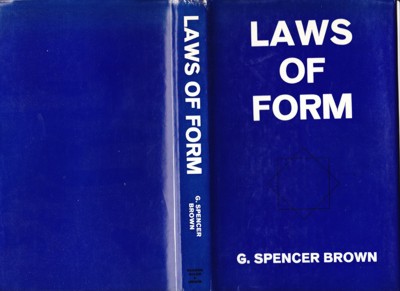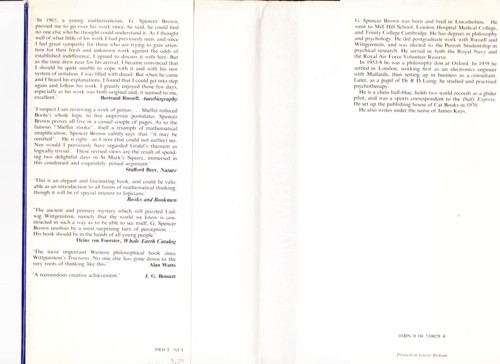George Spencer Brown
&
Laws of Form
&c.
As stated on the front page of this website (The Markable Mark), what is to be found in these pages is a reworking of material from the book Laws of Form. The book is somewhat controversial: the author (Spencer Brown) clearly felt that he had made a epoch-making discovery; some readers have agreed, others not. A common criticism is that what this book adds to the great edifice of Mathematical Knowledge is so nugatory or trifling as to be hardly worth the bother of reading - let alone writing - it.
(Click to enlarge)
My position is that the essential revelation of Laws of Form, namely the 'markable mark' (as I will call it), whilst of modest proportions, is an exceptionally perfect and indeed potent mathematical discovery. It seems likely that the cause of its being overlooked by earlier explorers of the same territory (e.g. C.S.Peirce [1]) lies in its very simplicity.
Like the tiny mustard seed that may yet grow into a great tree, the markable mark starts off small but has a remarkable capacity for development. Sown in the soil of an enquiring mind, this tiny thing gives rise, in an organic fashion, to a surprisingly extensive body of theory, as described in these pages.
It is true that much of this theory was known, albeit in a different form, to 'prior art': it is the 'giving rise to' that is important, and, I would urge, deserving of the reader's attention. Think of these pages, if you like, as a study in origination; where I am thinking of 'origin' not in the historical sense but as something more like the timeless grounding of one idea on or in another.
Ideas, such as arithmetic (in a more general sense than ordinary numerical arithmetic), equivalence, recursion, proof, algebra (again in a more general sense than ordinary numerical algebra), and so on, seem to arise naturally out of the humble subject matter.
It has been an interesting experience writing the computer programs behind the 'Play Areas' that are dotted through these pages, illustrating the workings of the mark. They are written in ActionScript, the object-oriented language which produces SWF files, which are in turn played by Adobe Flash Player, a common plug-in for web browsers. The basic object in ActionScript is the 'sprite', a graphical entity that is capable of moving about on your computer screen. But besides that, a sprite may have 'children' that are sprites as well, moving around on top of the parent - and in a sense, 'inside' the parent. Those familiar with the markable mark will be able to see that the sprite and the mark have something important in common. In working out the programs, I feel I have learnt as much about ActionScript (and computer languages generally) in the light of the mark, as about the mark in the light of ActionScript.
[1] The American logician C.S.Peirce (1839-1914) invented a system of 'Existential Graphs' intended as an 'iconic representation' of logical thought (as employed, particularly, by mathematicians). In his writings on the subject (especially the 'alpha' level of Existential Graphs) one can indeed find many of the ideas of Laws of Form, and a notation that is essentially the same. Yet Peirce never quite makes the breakthrough to clarity, certainly not to the luminous mathematical clarity of the markable mark and the circle-and-letter calculus. The reasons for this are debatable. One reason, probably, is that Peirce was aiming much higher and wider than Spencer Brown. The relevant sections from the Collected Papers of Peirce (published 1933) are available online at www.existentialgraphs.com. An interesting unpublished paper (MS 514) has been transcribed and annotated by J.F.Sowa at www.jfsowa.com.
On this website, see the page Peircean Illative Transformations.
There are parts of Laws of Form which I do not fully 'get' and have not included in my treatment. Such are the early chapters, say One to Three, the last one (Chapter Twelve), and Chapter Eleven, on 'imaginary truth values'. To my mind the givenness of the markable mark is the very beginning of the story; and attempts to justify its origin are unnecessary as well as unlikely to succeed. Chapter Eleven has inspired many people, but for me has more to do with ingenious electrical circuitry than with the sublime simplicity of the appearing and disappearing mark or 'form'. Of course I love the idea of proofs that proceed by means of imaginary truth values, but for me personally this has yet to become more than an alluring idea.
To find out more about Laws of Form and its author, George Spencer Brown, a good place to start is Wikipedia, which has articles on Laws of Form and Spencer Brown. For related material see also
www.lawsofform.org
(snapshot courtesy of the WayBackMachine;
the owner of lawsofform.org, Richard Shoup died in 2015)
www.boundarymath.org
www.iconicmath.com
www.wbricken.com.
Apart from Laws of Form (London: George Allen and Unwin, 1969) itself, the works that I have found particularly useful while composing these pages have been the following:
- Louis Kauffman's 'book in progress' Laws of Form - an Exploration in Mathematics and Foundations, available in rough draft at homepages.math.uic.edu/~kauffman/Laws.pdf
- William Bricken's article 'Distribution is not axiomatic' (1986), available at http://www.wbricken.com/pdfs/01bm/02logic/01transforms/04distribution.pdf
- Keith Peters, ActionScript 3.0 Animation (Berkeley: Friends of Ed, 2007)
- William Bricken, Lewis Carroll's Five Liars Puzzle
- Louis Kauffman, Robbins Algebra
Remarks on the Second Edition of this website
Since going online with the 'first edition' of this website in May 2012 I have had a re-think, resulting in numerous changes and additions; sufficient, I feel, to justify calling this new version the second edition.
I am very grateful to all who have given feedback on the first version. I would like to acknowledge in particular the fecundating effect of some remarks of William Bricken. I doubt if I have answered his points; but he put up several hares which had to be chased.
The main changes are as follows:
1) A shorter route to the 'Canon with respect to a variable', and thence to the Test Theorem (see the next paragraph).
2) Reconceptualization of the 'primary algebra' as a 'calculus of circles and letters'. The letters do not 'stand for' anything; they are just themselves. This new (or, at least, more explicitly articulated) attitude was brought on, in part, by the experience of working on the 'Play Areas' (Flash animations). The computer does not recognize that the letters have the capacity to 'stand for' anything other than themselves. I hope that this way of looking at the primary algebra will bring out the import of the Test Theorem, which says: two circle-and-letter expressions are equivalent if and only if they are equal under all substitutions of primitive values for the letters involved in the expressions.
3) I have made an attempt to relate the Laws of Form material to the orthodox mathematical study of the entities known as Boolean Algebras (a subject about which I knew practically nothing until very recently). To many, this will seem like a painstaking elaboration of the obvious. My aim is simply to set out as clearly as possible the connecting links between the two systems of thought, so that the reader may judge for him- or herself just how the two systems stand in relation to each other. The 'case for the prosecution' has always been that Laws of Form adds nothing to what was already known. But to say what is already known, in a new way - or basing it on new presuppositions - can be a highly significant, profound undertaking. Great art-works are like that. Does a Bach prelude, or a painting of sunflowers in a vase, tell you anything you didn't know before? If Laws of Form must be judged by the values of aesthetics, for its significance to become apparent, so be it.
4) Somewhat in this spirit, I have added a page on the solution of Lewis Carroll's 'Five Liars' puzzle, using the methods of Laws of Form (following Bricken's lead). The beautiful economy, and elegance, of this approach, using a notation consisting of nothing other than letters, circles and (in this case) squares, speaks for itself. There is, factually, nothing new being said here that could not be said by orthodox means: it is just said very well. In the beauty of the expression may we not, after all, learn something new?
G.B.-S., February 2013


